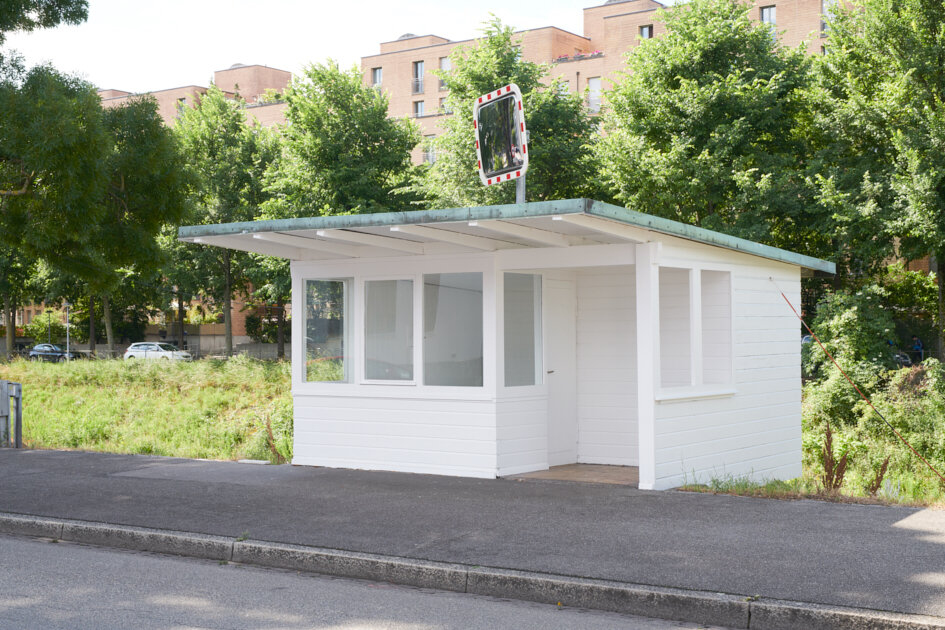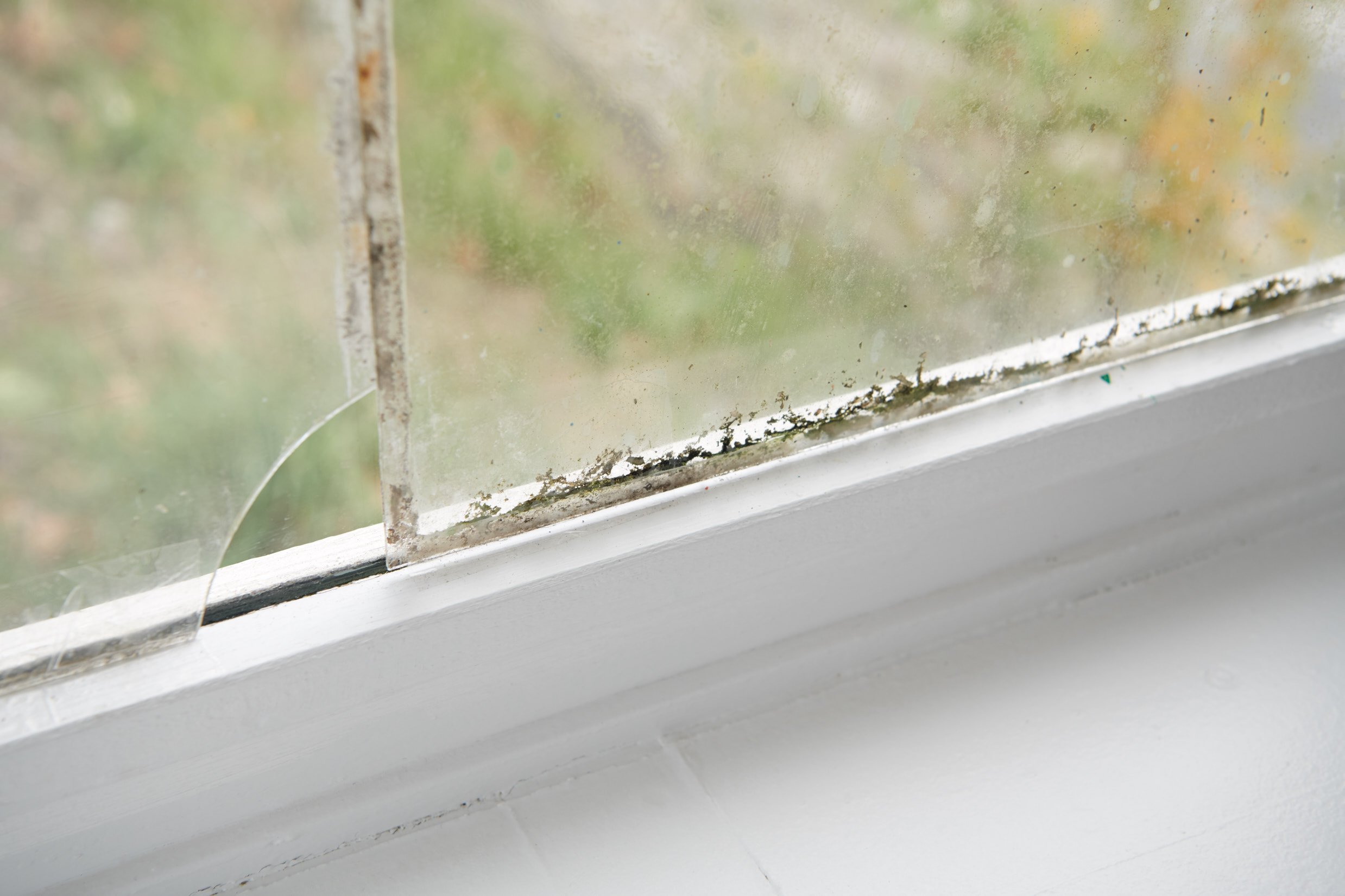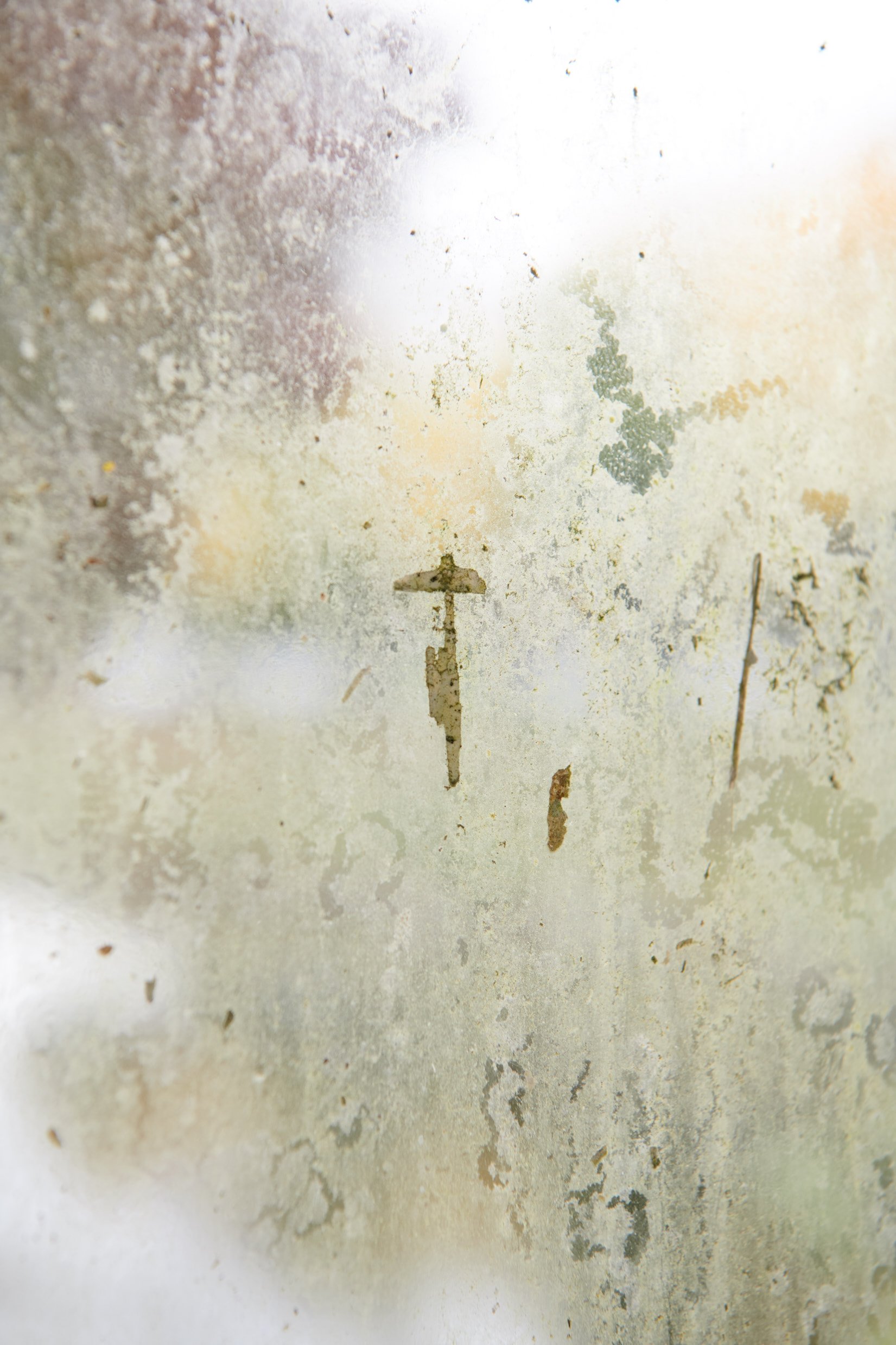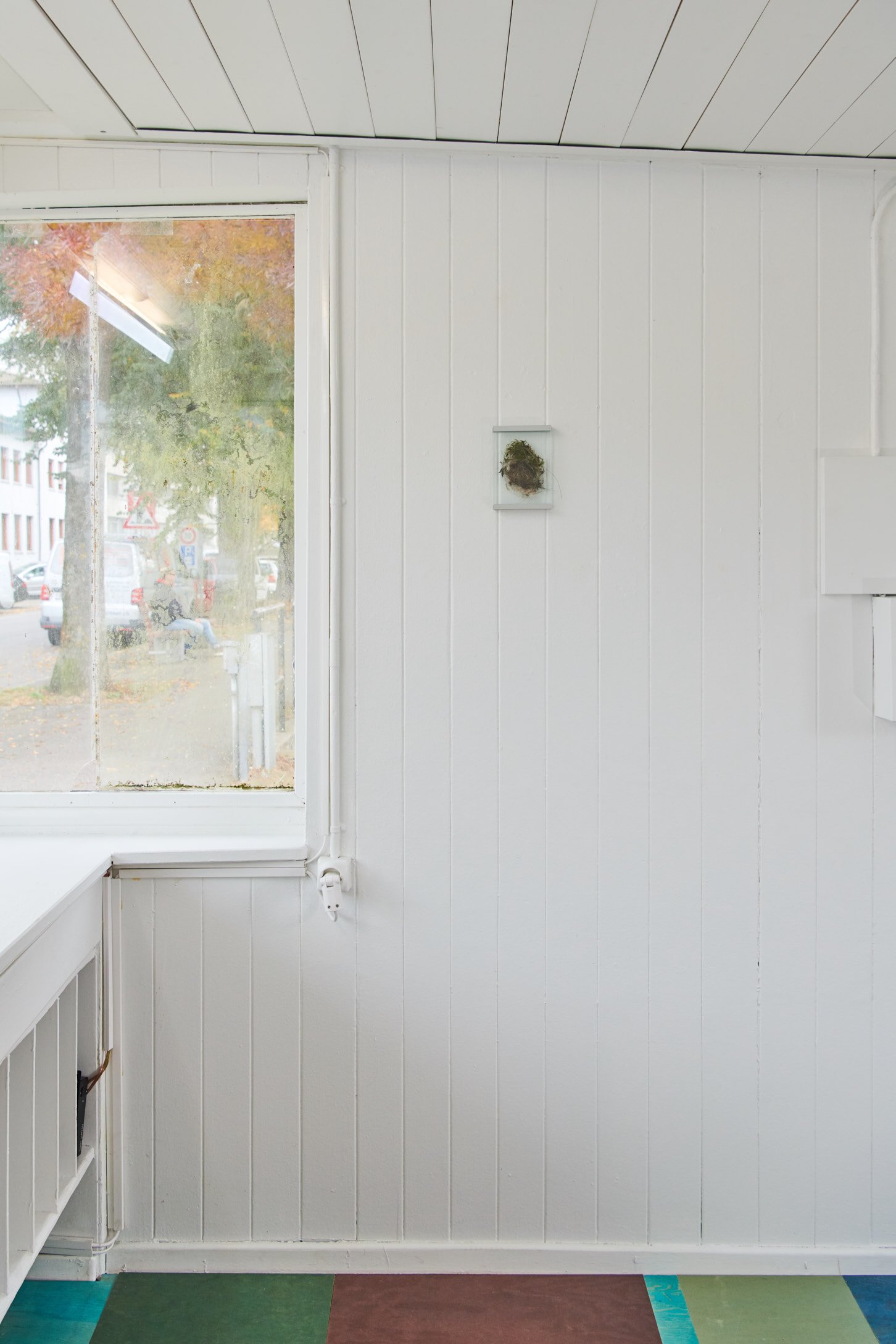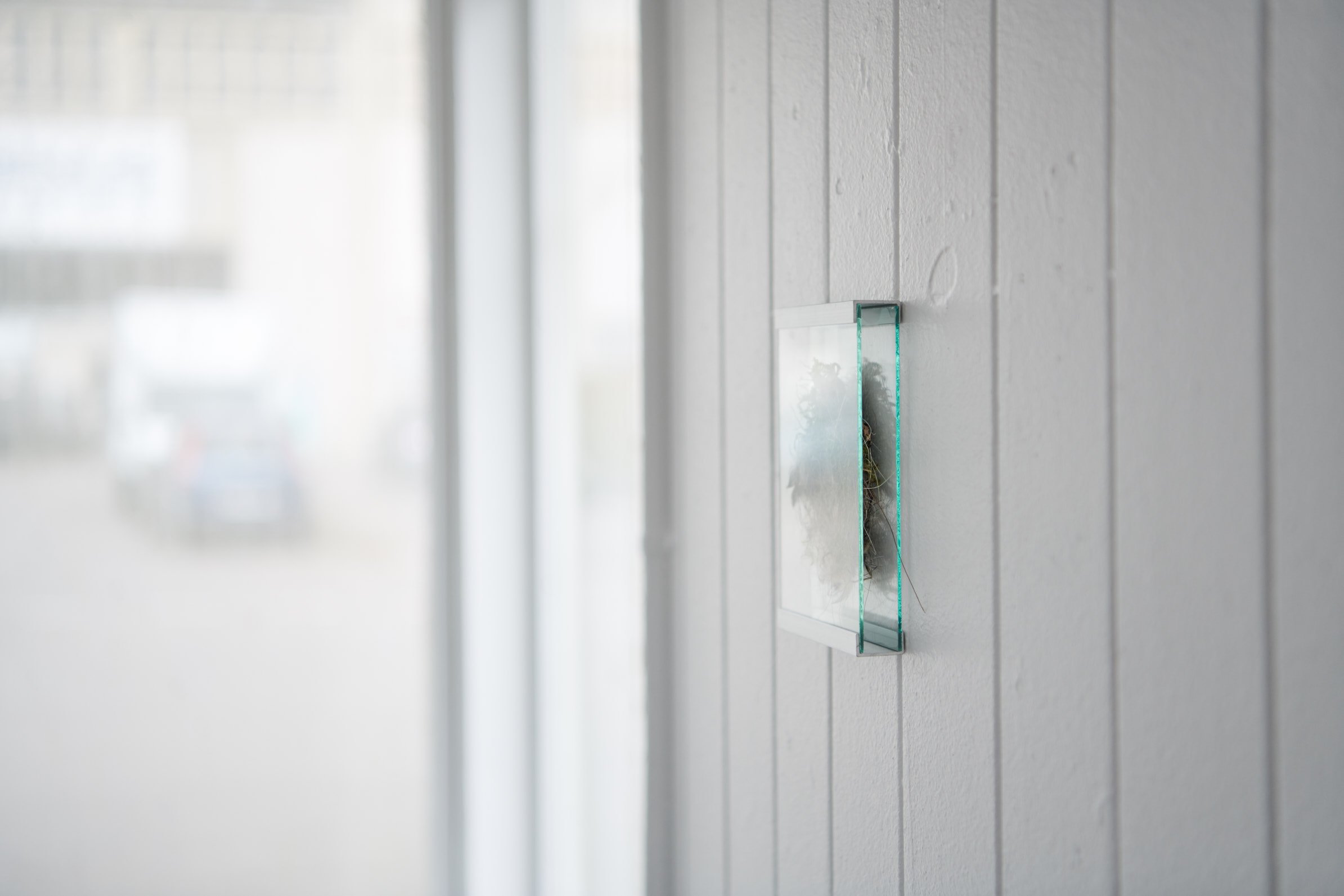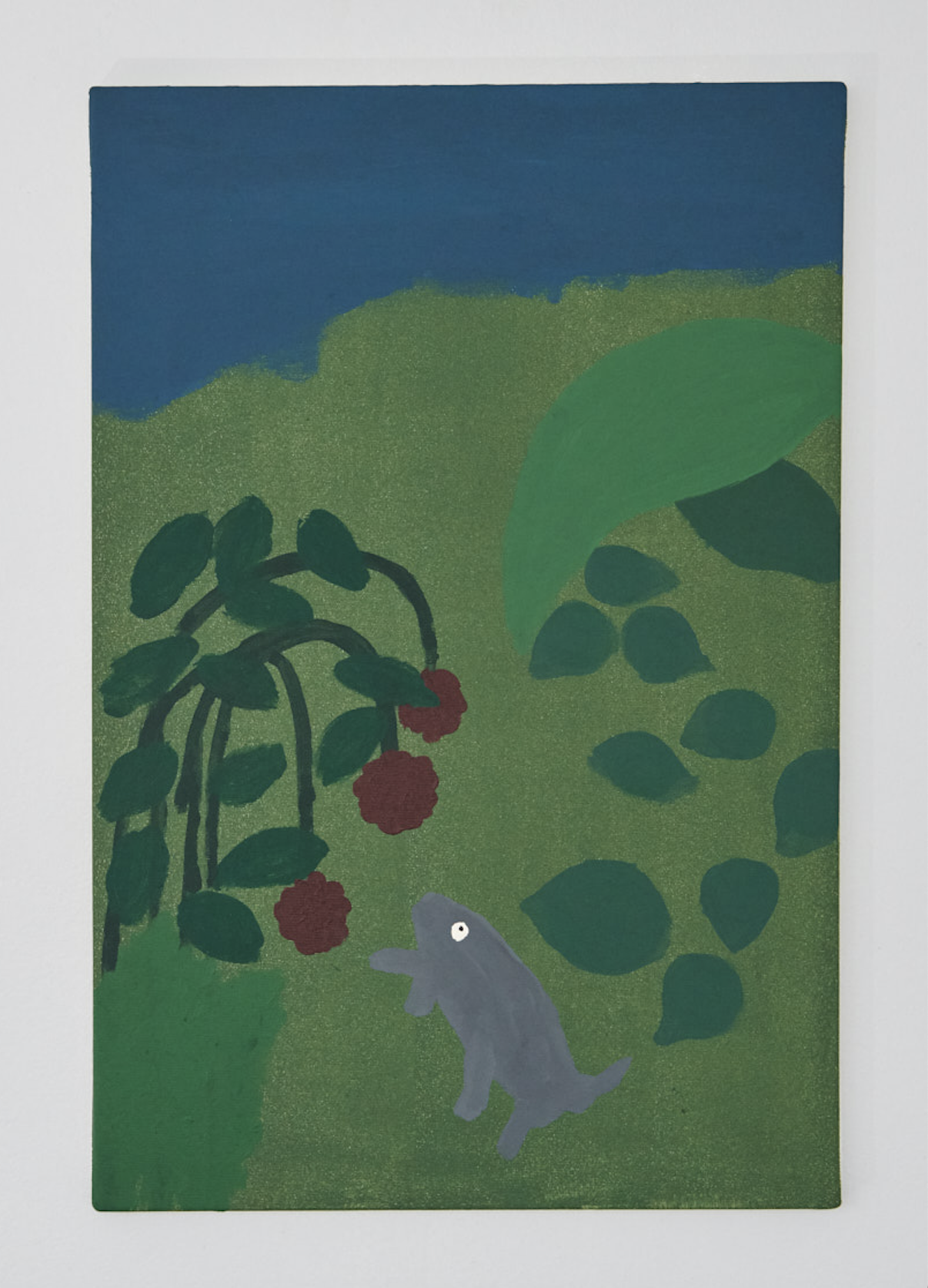06.11.21 - 30.01.22
Jan van Oordt
What really happens
to Swallows in the Winter?
Text: Isabel Zürcher
Translation: Bigna Pfenninger
Photo: Claude Gasser
The view is clouded. A second window glass, stained by moisture, moss and worm marks, blurs the vision into the former customs house. There is someone here claiming the city’s smallest public art space and at the same time quietly rebelling against its clean varnish. The semi-transparent window lends the white cube exhibition space the appearance of a shed. Such a lowering of the perceived utility of the building probably sharpens our eyes and senses: in the shadow of its new insignificance, animals may dwell inconspicuously where shrubs grow and wild grass hosts insects that have become rare. Within the atmosphere of the shed, twilight again becomes an event. The video work “Evening in the Upper Garden” (2021) shows the sun slowly setting over forest and garden. Jan van Oordt (* 1980) has placed the screen below the counter, mimicking a hidden window, and the video’s fixed mode seems to draw from painting techniques of the late 19th century. The unexcited depiction of the landscape captures the mobility of light, gifting time just for viewing.
In terms of media, Jan van Oordt employs a broad repertoire. He chooses from collage, painting, object and installation art to the precise degree that allows for things to include us in their intimate dialogue. In the semi-darkness of a picture background placed next to the window, three heavy raspberries bow toward a gray four-legged friend. And suddenly it is clear that we are not alone in this room: the dog’s eye penetrates it with wide-awake attention. The blank space above the caption next to the door asks us the show title’s question: What really happens to Swallows in the Winter?
The work of Jan van Oordt is informed by the place that became the centre of his life a few years ago. The artist calls the small weekend abode next to the main house on the outskirts of the municipality of St. Imier "La Dépendance". As carpenter and roofer, he has developed it into a self-managed summer residence. Here, the artist literally lays the groundwork for production, exchange and reflection. Here, he takes notice of the environment and registers the signs of coexistence between humans and animals. Birds make use of leftover dog hair and chicken feathers. Their nest absorbs its environs and presents the circular economy as an obvious give and take. But it is not only a contemplative act. Our claim to land remains possessive in character, and wherever we pick up material, we do so in order to include and exclude. From such fringes of our collective attention, Jan van Oordt undermines the assertive rhetoric that woos us with the promise of lasting idylls.
Isabel Zürcher, October 2021
Questions for Jan van Oordt (Isabel Zürcher)
Are there things that you learn exclusively or predominantly from your creative practice?
My artistic work is fed by a wide variety of fields of life; knowledge and skills merge smoothly. For example, I learned a lot about construction and building materials during the renovation of my home, which now reappears in my work. I think most likely media-specific knowledge or of course the submissions of dossiers, language….
Do you experience moments of happiness when working? And if so, what constitutes this happiness?
Sometimes I have the feeling that something happens that is somehow coherent or interesting, without being able to describe it exactly. That makes me happy.
What or whom does your art need most?
Viewers.
Is your practice concerned with politics? With poetry? With both?
This is a very open question... It depends on the understanding of politics and poetry. For me, in any case. If „political“ with regard to art describes its relation to public life, to one‘s own relationship and understanding of „the world“, then definitely.
What do you consider criteria for success?
Success can be financial, recognition, praise, criticism... Of course, it is nice when I notice that a work is understood or arouses interest and a discussion takes place. This can take different forms like invitations to exhibitions, sales, prizes or feedback and conversations.
What can art criticism do (in the best of cases)?
Perhaps art criticism can prudently spin discourses in order to critically accompany art experiences and to embed mediation?
Say you are alerted, disturbed, shocked or excited by another artist’s work. Which aspects most strongly trigger your interest?
For me, I think that insights have to do with the fact that for a moment a „world“ coincides with one‘s own experiences and thus a new context of meaning opens up. But often I can not linguistically grasp the trigger for it.
Die Einsicht ist getrübt: Ein von Feuchtigkeit, Moos und Wurmspuren gezeichnetes, zweites Glas trübt den Blick ins ehemalige Zollhäuschen. Da nimmt einer den Raum ein und lehnt sich zugleich leise auf gegen den sauberen Anstrich dieses kleinsten öffentlichen Kunstraums der Stadt. Die halbtransparenten Fenster geben dem White Cube den Anschein eines Schuppens. Unter den Vorzeichen dieses niederschwelligen Nutzbaus sehen wir wahrscheinlich genauer: Im Schatten seiner Bedeutungslosigkeit hausen unscheinbar Tiere, wachsen Stauden, bewirtet wild wachsendes Gras Insekten, die rar geworden sind. Aus der Schuppen-Perspektive wird auch Dämmerung zum Ereignis: Der «Abend im oberen Garten» (2021) lässt am Bildschirm die Sonne langsam untergehen über Wald und Garten. Wie ein verstecktes Fenster hat Jan van Oordt (*1980) sein Video unter den Tresen versenkt. Die Fixeinstellung scheint anzuknüpfen an Malerei des ausgehenden 19. Jahrhunderts: Im unaufgeregten Landschaftsausschnitt erfasst sie die Beweglichkeit des Lichts, schenkt Zeit allein für die Betrachtung.
Medial bewegt sich Jan van Oordt in einem breiten Repertoire. Objektkunst, Collage, Malerei und Installationen dosiert er mit Vorliebe so, dass uns die Dinge einschliessen in ihr intimes Zwiegespräch. Drei schwere Himbeeren neigen sich im Halbdunkel eines Bildgrunds neben dem Fenster einem grauen Vierbeiner zu. Plötzlich ist klar, dass wir nicht alleine sind: Sein Auge durchdringt den Raum mit hellwacher Aufmerksamkeit. Die Leerstelle über den Bildbeischrift neben der Tür spielt uns die Titelfrage zu: What really happens to Swallows in the Winter?
Das Schaffen von Jan van Oordt nährt sich nicht zuletzt an jenem Ort, der vor ein paar Jahren zu seinem Lebensmittelpunkt geworden ist. «La Dépendance» nennt der Künstler ein kleines Wochenendhäuschen neben dem Wohnhaus am Ortsrand der Gemeinde St. Imier. In der Rolle des Zimmermanns, Schreiners, Dachdeckers hat er es zu einer selbst verwalteten Sommerresidenz ausgebaut. Hier legt der Künstler auch im wörtlichen Sinn den Boden für Produktion, Austausch, Reflexion. Hier nimmt er Notiz von der Umgebung, registriert Zeichen der Co-Existenz von Mensch und Tier. Vögel bedienen sich an liegen gebliebenem Hundehaar oder Hühnerfedern. Ihr Nest absorbiert die Umgebung, weist die Kreislaufwirtschaft aus als naheliegendes Geben und Nehmen. Nur beschaulich ist das nicht: Possessiv bleibt unsere Landnahme, und wo wir Material zur Hand nehmen, dient es auch zur Ein- und Ausgrenzung. Von den Rändern der kollektiven Aufmerksamkeit her untergräbt Jan van Oordt die Behauptungs-Rhetorik, die uns umwirbt mit dem Versprechen bleibender Idyllen.
Isabel Zürcher, Oktober 2021
Fragen an an van Oordt (Isabel Zürcher)
Gibt es Dinge, die du nur oder vor allem aus deiner Arbeit lernst?
Meine künstlerische Arbeit speist sich aus verschiedensten Lebensfeldern; Wissen und Fertigkeiten gehen da fliessend ineinander über. Beispielsweise habe ich viel über Konstruktion und Baustoffe bei der Renovation von meinem Zuhause erfahren, was jetzt in meiner Arbeit wieder auftaucht. Ich denke am ehesten medienspezifisches Wissen oder natürlich Dossiereingaben, Sprache...
Kennst du Glücksmomente beim Arbeiten? Und wenn ja: worin besteht das Glück?
Manchmal eröffnen sich Fährten beim arbeiten bei denen ich plötzlich das Gefühl habe da passiert etwas das irgendwie stimmig oder interessant ist, ohne es genau bezeichnen zu können. Das macht mich dann jeweils froh.
Was oder wen braucht deine Kunst am meisten?
Betrachter*innen
Hat dein Schaffen mit Politik zu tun? Mit Poesie? Mit beidem?
Das ist jetzt eine eine sehr offene Frage... Das kommt auf das Verständnis von Politik und Poesie an. Für mich auf jeden Fall. Wenn „politisch“ in der Kunst deren Bezug zum allgemeinen öffentlichen Leben, zum eigenen Verhältnis und Verständnis von „Welt“ umschreibt, auf jeden Fall.
Was sind für dich Kriterien des Erfolgs?
Erfolg kann finanziell sein, Anerkennung, Lob, Kritik... natürlich ist es schön wenn ich bemerke das ein Werk verstanden wird oder Interesse weckt und eine Auseinandersetzung stattfindet. Das kann jeweils in verschiedenen Ausformungen wie Einladungen zu Ausstellungen, Verkäufen, Preisen oder Rückmeldungen und Gesprächen annehmen.
Was kann Kunstkritik (im besten Fall)?
Vielleicht umsichtig Diskurse spinnen, um Kunsterfahrung hinterfragend zu begleiten und Mediation kritisch einzubetten?
Wenn dich Kunst (von anderen Künstler*innen) aufweckt, verstört, erschüttert, begeistert:
Was kann ein Auslöser sein?
Ich denke Erkenntnisse haben für mich damit zu tun das eine „Welt“ in einem Moment mit den eigenen Erfahrungen zusammenfällt und sich damit ein neuer Sinnzusammenhang öffnet. Der Auslöser ist für mich aber oft nicht sprachlich fassbar.
Drawings for la Dépendance
Drawings for la Dépendance is an analog crowdfunding project launched by Jan van Oordt in 2017 to finance the purchase of a small weekend cottage.
The goal is to collect 35 000 works on paper in A6 format, which is the price of the house. Subsequently, the works will be shown in exhibitions and sold. A part will also be bound into books. Each drawing costs 1.- The house is operated during the summer months since 2018 as an artists residence and exhibition space by Jan van Oordt.
The current status (January 2022) of the collection is 17766.
All artworks were made by other artists.











Apartment Drawing Exhibition
Gartenstrasse 72, 4052 Basel / Raphael Bottazzini
